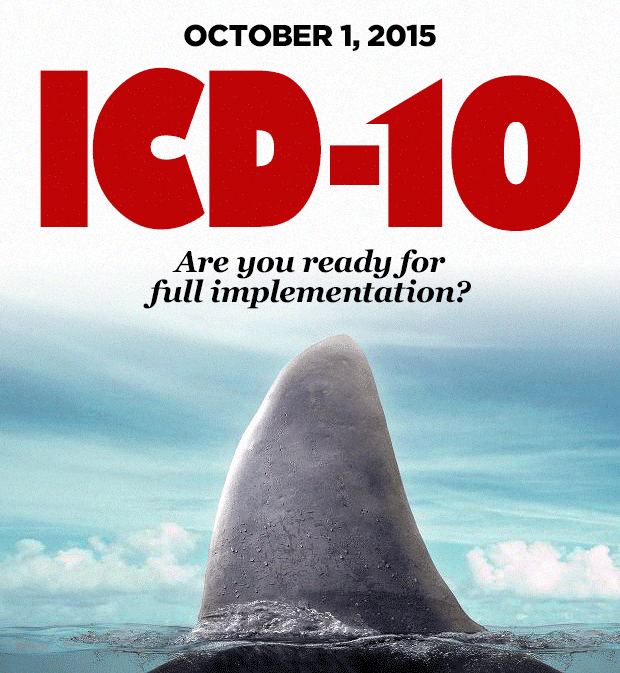363 and Counting!
Cue the Shark Song!
Da-dun. Da-dun. Da-dun, da-dun, da-dun…
Can you hear it in your head? The “Jaws” theme playing as the fin approaches closer and closer through the water…
It’s coming! No not a ferocious shark with big teeth but a big monster for sure and it’s called…
 ICD-10!!!!!!!!!
ICD-10!!!!!!!!!
Not a blog about sharks…
No this isn’t a blog about shark bites, although ironically we’re sure there’s a new ICD-10 code to cover a shark bite somewhere out there amongst the 68,000 codes that we’ll be forced to use.
ICD-10 is only 363 days away. October 1, 2015 will usher in the use of the International Classification of Disease Version 10 diagnosis coding scheme. We’ve blogged about this before and to say this is huge is really an understatement.
So we’re blogging about it again on this the day one-year before full implementation begins.
Explain please!
Even though EMS has no ability to diagnose in the field, once you have written your Patient Care Report and pass it onto your billing office the people in that office, will then review it and apply the ICD-10 diagnosis code that best represents the EMS scenario to the payer source that is billed, hopefully resulting in reimbursement.
Right now we’re working on Version 9 of the coding system. Come next year on October 1st the big switch will happen.
This past Wednesday was the day that the Federal Government originally called for a mandate to transition. However the provider community (physicians, hospitals, insurance companies, third-party billing companies, EMS…) kicked and screamed loudly so Washington backed down and gave us all another year to get our act together.
And now here we are…one year away from D-Day.
More codes, more detail
Going from 13,000 to 68,000 of anything is a big leap. A leap of 55,000 things to be exact!
In this case more equates to additional complexity. No surprise there. How this will potentially affect your EMS agency and mine along with our respective billing offices is colossal.
In a word, while not needing to be a PhD level dissertation, the Patient Care Report’s documentation will have to rise to an entirely new level of excellence that the EMS industry has yet to call for globally.
Where now, some generalized statements written in our PCR can be extracted to support the use of a code, when ICD-10 arrives on the stage the level of detail required about the EMS scenario as documented in the PCR will need to be level sharp and pinpoint accurate.
This new version of diagnosis coding will include and incorporate potential outcomes, mechanism of injury, contributing factors and the like. For example simply stating in your documentation that you treated and transported a patient with a leg fracture will enable coding, today. Documenting a leg fracture one year from today will probably mean that you will have been charged with documenting the location (a femur fracture, proximal to the knee) with complications (open, compound leg fracture of the femur proximal to the knee) and include the mechanism of injury (leg fracture is due to motor vehicle accident involving a passenger car versus tractor-trailer.)
And then what do we do?
The fear of every billing office (not just EMS- doctors and hospitals too) is that the actual hands-on providers will miss the document goals necessary to support an appropriate diagnosis code. We billers fear that EMS providers will not understand the level of detail that will be necessary to pick just one of the many thousands of possible diagnosis codes that can potentially fit the scenario.
And then what do we do?
That’s the question we don’t want to be asking a year from today so here are three steps we recommend.
Read, reinforce and review
Read all you can on the subject, now! Read this space. Read EMS publications. Read ICD-10 articles. Get in the know!
Reinforce your documentation efforts across all of your EMS providers. Your street staff needs to be writing better PCR narratives right now. It’s not an option. Come next year this time thready narratives will translate into claims that can’t be coded.
Review all of your processes. If your using an outsource billing company be sure they are readying their office for these changes (Enhanced is…) If utilizing an in-house billing staff, make sure they are reviewing all processes and preparing to train for the coding transition. Also, take a look at any billing software plus prepare a budget for “what if” in the event that 10/1/2015 comes and the payer community isn’t geared up to pay incoming claims with the new codes or the software can’t handle them.
Don’t wait until 9/30/2015 and miss the mark. Act now!